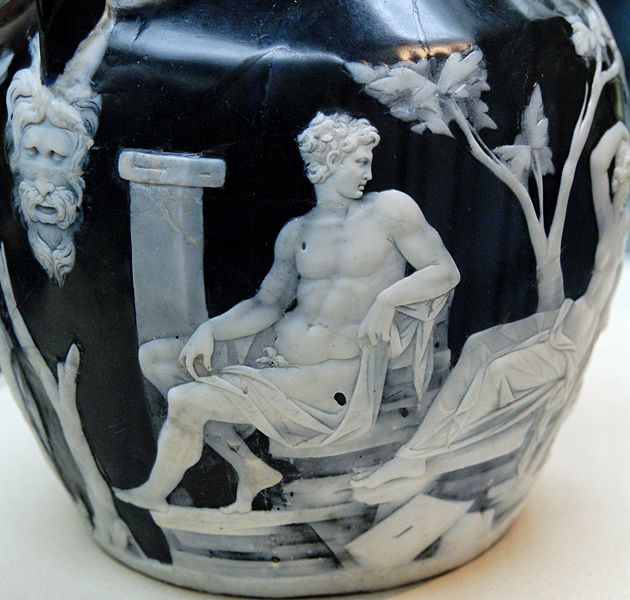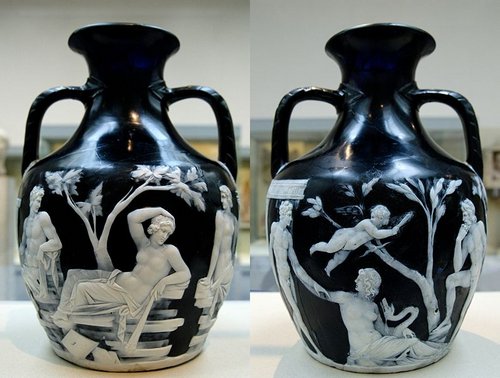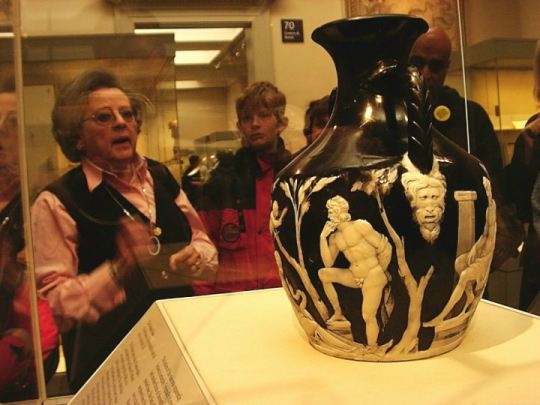The Barberini vase or Portland Vase as it became known as, is the most famous cameo-glass vessel from antiquity. it has been studied for centuries by scholars trying to determine its original utilitarian purpose and the perplexing meaning of its idyllic scenes. Yet these events are all part of the extraordinary heritage of the so-called Portland Vase, which, for all its beauty and grandeur, remains today an artistic mystery of the ages.
Not much is known about the history of the vase. Scholars can not determine who owned the vase in ancient Rome, and even it’s emergence during the Renaissance period is shrouded in mystery. It was said to have been discovered in a sarcophagus outside Rome in the early 1580’s, but there seems to be no contemporary documentation of its unearthing at this time. By the early seventeenth century it was owned by Cardinal Francesco Maria Borbone del Monte, who died in August 1626 and whose heir, Alessandro, sold it to Cardinal Antonio Barberini. The vase remained in the possession of the Barberini family, distinguished collectors of art in Rome who exhibited majestic paintings and sculptures in their palace, for 150 years.
”The scenes on the Portland Vase have been interpreted many times with a historical or a mythological slant. It is enough to say that the subject is clearly one of love and marriage with a mythological theme. The ketos (sea-snake) places it in a marine setting. It may have been made as a wedding gift.It is not known exactly where and when the vase was found. It is recorded as being seen in 1601 when it was in the collection of Cardinal del Monte in Italy. After the cardinal’s death it was bought by the Barberini family where it remained for 150 years. Eventually, in 1778, it was purchased by Sir William Hamilton, British Ambassador at the Court of Naples. He brought it to England and sold it to Margaret, dowager Duchess of Portland, less than two years later, in 1784. In 1786 it came into the hands of her son, the third Duke of Portland, and it was he who lent it to Josiah Wedgwood, who made it famous through various copies.” ( British Museum )
Who made it? What was its secret? And through how many hands had it passed before it came to England?
At first the vase was assumed to be the burial urn if Marcus Aurelius Antoninus and his wife, Faustina, and the story that of the famous physician Galen diagnosing their daughter’s mysterious illness as love for a ropedancer. Certainly this interpretation can be made to fit the figures on the vase, though what part the serpent played is difficult to understand, and the daughter’s known taste for muscular young men such as wrestlers, ropedancers and gladiators supports it. Unfortunately, the likelihood of a Roman emperor decorating his burial urn with the story of his daughter’s casual love affairs appears remote.

Portland vase. ''English: Seated man looking at a recling woman, detail of the side A of the Portland Vase. Cameo-glass, probably made in Italy ca. 5-25 AD.''
The other interpretations are a similar mixture of the plausible and the absurd. With minor adjustments, the figures have been made to fit the love stories of Medea and Jason, Theseus and Amphitrite, Jupiter and Olympias, or Zeus and Leda, in which case the serpent would have to be a swann. To Erasmus Darwin, refreshingly, but implausibly, the figures suggest a fertility cult from Asia Minor, if so, the male figure must have been the most reluctant hero in the history of fertility rites.
To these suggestions, there were constant additions.But in the middle of the nineteenth century the vase was tghrust far more dramatically before the public eye. For on Friday, February 7, 1845, William Lloyd secured his only niche in history when he stepped from a crowd of spectators in the British Museum and hurled a stone sculpture through the only perfect surviving example of Greek cameo glass. It was not a premeditated act, not the act of a madman. He simply felt the sudden uncheckable desire to smash something, and the most famous vase in the world happened to be the handiest and most tempting target in sight.
Now, carefully pieced together again, it stands unostentatiously in the British Museum. Probably few of those who stop to look realize the mysteries that still surround it. But whatever the possibilities of its strange career, they can be little more remarkable than the certainties. And what happened to it during its first seventeen hundred years of existence,
hall never know for certain. Like the story told by the vase, it is open to speculation.






 COMMENTS
COMMENTS